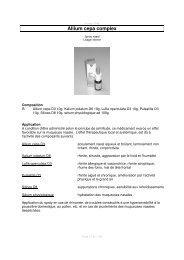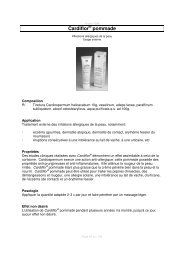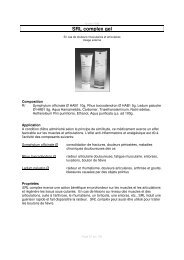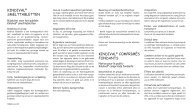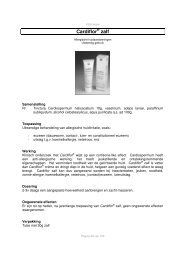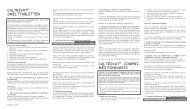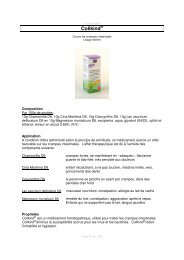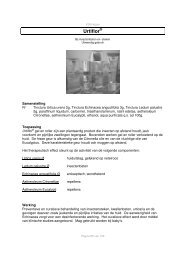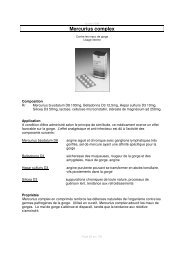Ginkgo special extract EGb 761® in vertigo: A systematic review of ...
Ginkgo special extract EGb 761® in vertigo: A systematic review of ...
Ginkgo special extract EGb 761® in vertigo: A systematic review of ...
You also want an ePaper? Increase the reach of your titles
YUMPU automatically turns print PDFs into web optimized ePapers that Google loves.
The Internet Journal <strong>of</strong> Otorh<strong>in</strong>olaryngology TM<br />
<strong>G<strong>in</strong>kgo</strong> <strong>special</strong> <strong>extract</strong> <strong>EGb</strong> 761® <strong>in</strong> <strong>vertigo</strong>:<br />
A <strong>systematic</strong> <strong>review</strong> <strong>of</strong> randomised, double-bl<strong>in</strong>d, placebo-controlled<br />
cl<strong>in</strong>ical trials<br />
Karl-Friedrich Hamann<br />
Pr<strong>of</strong>essor<br />
ENT Hospital<br />
Kl<strong>in</strong>ikum rechts der Isar<br />
Technical University<br />
Munich, Germany<br />
Citation:<br />
Karl-Friedrich Hamann: <strong>G<strong>in</strong>kgo</strong> <strong>special</strong> <strong>extract</strong> <strong>EGb</strong> 761® <strong>in</strong> <strong>vertigo</strong>: A <strong>systematic</strong> <strong>review</strong> <strong>of</strong><br />
randomised, double-bl<strong>in</strong>d, placebo-controlled cl<strong>in</strong>ical trials: The Internet Journal <strong>of</strong><br />
Otorh<strong>in</strong>olaryngology. 2007; Volume 6, Number 2.<br />
Abstract<br />
Background: The concept for medical treatment <strong>of</strong> <strong>vertigo</strong> has changed dur<strong>in</strong>g the last 30 years, because the<br />
dependence <strong>of</strong> the vertig<strong>in</strong>ous sensation on vestibular compensation and the dependence <strong>of</strong> vestibular<br />
compensation on the state <strong>of</strong> vigilance were recognized.<br />
Methods: In this <strong>systematic</strong> <strong>review</strong> experimental studies <strong>of</strong> the <strong>in</strong>fluence <strong>of</strong> the <strong>special</strong> <strong>G<strong>in</strong>kgo</strong> <strong>extract</strong> <strong>EGb</strong><br />
761® on vestibular compensation <strong>in</strong> animals and randomized, double-bl<strong>in</strong>d cl<strong>in</strong>ical studies <strong>of</strong> <strong>EGb</strong> 761® <strong>in</strong><br />
vestibular and non-vestibular <strong>vertigo</strong> are described and critically evaluated.<br />
Results: The beneficial effect <strong>of</strong> <strong>EGb</strong> 761® on vestibular compensation was demonstrated <strong>in</strong> precl<strong>in</strong>ical and<br />
cl<strong>in</strong>ical studies.<br />
Conclusion: Evidence <strong>of</strong> efficacy <strong>of</strong> <strong>EGb</strong> 761® <strong>in</strong> the treatment <strong>of</strong> vertig<strong>in</strong>ous syndromes can be derived from<br />
the available studies.<br />
This article has been published <strong>in</strong> German language before: Hamann KF. <strong>G<strong>in</strong>kgo</strong>-Spezialextrakt bei<br />
Schw<strong>in</strong>del. E<strong>in</strong> systematischer Review randomisierter, doppelbl<strong>in</strong>der, placebo-kontrollierter kl<strong>in</strong>ischer<br />
Prüfungen. HNO 2007;55:258-263. Submission <strong>in</strong> English language to The Internet Journal <strong>of</strong><br />
Otorh<strong>in</strong>olaryngology was approved by Spr<strong>in</strong>ger.<br />
Background<br />
As is generally known, vertig<strong>in</strong>ous symptoms are on the whole amongst the most frequently registered<br />
compla<strong>in</strong>ts. Although the fact that different pathological conditions could cause different types <strong>of</strong><br />
<strong>vertigo</strong> was recognised early on, for a long time attempts were made to treat the symptom <strong>vertigo</strong><br />
without further differentiation. As a result, antihistam<strong>in</strong>es such as dimenhydr<strong>in</strong>ate were commonly<br />
used <strong>in</strong> the forties. These had considerable sedative side effects, however. Other substances such as<br />
thiethylperaz<strong>in</strong>e (Torecan ® ), dihydrobenzperidol or even diazepam, which may be classified as<br />
tranquillisers, were also used as antivertig<strong>in</strong>ous drugs. Although the short-term therapeutic effects<br />
were unquestionable, the concomitant sedative effects excluded long-term therapy. Moreover, at<br />
about the beg<strong>in</strong> <strong>of</strong> the seventies – at first only <strong>in</strong> animal experiments – the underly<strong>in</strong>g mechanisms <strong>of</strong><br />
vestibular compensation ( 1 ), i.e. the recovery processes follow<strong>in</strong>g vestibular lesions, and their<br />
dependence on vigilance and pharmaceuticals ( 2 ) were elucidated. The f<strong>in</strong>d<strong>in</strong>g that sedative<br />
substances <strong>in</strong>hibit vestibular compensation processes led to conventional “antivertig<strong>in</strong>ous agents” only<br />
be<strong>in</strong>g recommended for acute therapy, not for long-term treatment. This is an important aspect with<br />
regard to different cl<strong>in</strong>ical pictures ( 3 ) and driv<strong>in</strong>g capability ( 4 ).
Vestibular Compensation<br />
The basis for all the concepts about vestibular compensation is the observation that the unilateral loss<br />
<strong>of</strong> a peripheral vestibular organ <strong>in</strong>itially leads to marked symptoms with severe rotational <strong>vertigo</strong>,<br />
spontaneous nystagmus to the healthy side and ataxia ( 5 ). However, this complex <strong>of</strong> symptoms<br />
becomes less severe and largely disappears after a certa<strong>in</strong> period <strong>of</strong> time, which differs considerably<br />
between <strong>in</strong>dividuals and from species to species. These natural recovery processes may also be<br />
observed <strong>in</strong> animal behaviour experiments and are possibly related to neuronal phenomena which<br />
may be described as an imbalance at the level <strong>of</strong> the vestibular nuclei ( 6 , 7 ). Certa<strong>in</strong> parameters <strong>of</strong><br />
neuronal activity, such as spontaneous activity, and response to dynamic stimuli (such as ga<strong>in</strong> and<br />
phase) show a tendency to reequilibrate. What is <strong>in</strong>terest<strong>in</strong>g is that vestibular compensation may be<br />
improved by additional <strong>in</strong>put from the visual system ( 8 ). These phenomena have been considered to<br />
be the neuronal correlates <strong>of</strong> the vestibular recovery processes.<br />
The recovery from static symptoms, such as <strong>vertigo</strong> at rest, spontaneous nystagmus and ataxia, which<br />
may be completely restored, should be differentiated from the recovery <strong>of</strong> dynamic symptoms, such as<br />
asymmetrical rotation-<strong>in</strong>duced nystagmus reactions and asymmetrical optok<strong>in</strong>etic nystagmus, which is<br />
only <strong>in</strong>complete ( 9 ). What is certa<strong>in</strong> is that vestibular compensation is associated with re-adjustment<br />
processes <strong>in</strong> central nervous structures, primarily <strong>in</strong> the vestibular nucleus ( 10 ).<br />
Possibilities for improv<strong>in</strong>g compensation<br />
When these f<strong>in</strong>d<strong>in</strong>gs are taken <strong>in</strong>to account, the recommendations made <strong>in</strong> the forties for treat<strong>in</strong>g<br />
vestibular diseases by physical therapy appear, retrospectively, to have a rational basis. Cawthorne<br />
and Cooksey's methods ( 11 ) form the basis <strong>of</strong> many tra<strong>in</strong><strong>in</strong>g programmes. These have been<br />
extended or modified many times. In Germany, the s<strong>in</strong>gle-bl<strong>in</strong>d studies <strong>of</strong> Hamann ( 12 ) and later<br />
Strupp et al. ( 13 ) were able to confirm the cl<strong>in</strong>ical success <strong>of</strong> vestibular exercise programmes.<br />
The goal <strong>of</strong> all habituation tra<strong>in</strong><strong>in</strong>g exercises is to more or less specifically stimulate vestibular<br />
performance, but above all to <strong>in</strong>clude auxiliary systems, such as the visual and proprioceptive systems,<br />
<strong>in</strong> the compensation processes. Numerous observations and studies have demonstrated that<br />
vestibular compensation may be <strong>in</strong>fluenced by pharmacological agents ( 2 , 7 ).<br />
Initially, animal experiments were used to <strong>in</strong>vestigate how the compensation processes are <strong>in</strong>fluenced<br />
by pharmaceutical agents. In general, it appears that stimulants such as amphetam<strong>in</strong>e, caffe<strong>in</strong>e or<br />
even strychn<strong>in</strong>e accelerate compensation, while sedatives such as high doses <strong>of</strong> alcohol or<br />
barbiturates slow down the process ( 2 ). Consequently, an ideal compensation-enhanc<strong>in</strong>g substance<br />
should have no sedative properties but should have central stimulatory actions <strong>in</strong> the vestibular nuclei.<br />
Composition and pharmacology <strong>of</strong> <strong>EGb</strong> 761®<br />
<strong>EGb</strong> 761 ® is a <strong>special</strong> <strong>extract</strong> <strong>of</strong> <strong>G<strong>in</strong>kgo</strong> biloba leaves (herbal drug-<strong>extract</strong> ratio 35-67:1)<br />
standardised to 22 - 27 % <strong>G<strong>in</strong>kgo</strong> flavone glycosides and 5 - 7 % terpene lactones (g<strong>in</strong>kgolides,<br />
bilobalide) which conta<strong>in</strong>s less than 5 ppm g<strong>in</strong>kgolic acids. Experimental <strong>in</strong>vestigations have shown<br />
flavone glycosides and terpene lactones to be the most important active <strong>in</strong>gredients ( 14 ).<br />
<strong>EGb</strong> 761 ® has been shown to have neuroprotective effects, <strong>in</strong>clud<strong>in</strong>g improved energy supply by the<br />
mitochondria, antioxidative or radical captur<strong>in</strong>g properties, and to improve cerebral perfusion (through<br />
reduction <strong>in</strong> blood viscosity) and glucose utilisation ( 14 ). The EEG shows that <strong>EGb</strong> 761 ® appears to<br />
have effects that <strong>in</strong>crease vigilance and cognitive activation ( 15 , 16 ). One <strong>of</strong> the ma<strong>in</strong> <strong>in</strong>dications for<br />
<strong>EGb</strong> 761 ® is dementia (Alzheimer's disease and vascular dementia). Which mechanisms play the<br />
decisive role <strong>in</strong> the action <strong>of</strong> <strong>EGb</strong> 761 ® <strong>in</strong> <strong>vertigo</strong> and vestibular compensation cannot be stated<br />
def<strong>in</strong>itively. Depend<strong>in</strong>g on the pathogenetic background, both antioxidative properties and activation <strong>of</strong><br />
cerebral metabolism may be possible as well as vigilance-enhanc<strong>in</strong>g and cognitive activation effects.
<strong>EGb</strong> 761 ® and vestibular compensation <strong>in</strong> animal experiments<br />
An <strong>in</strong>fluence <strong>of</strong> <strong>EGb</strong> 761 ® on the vestibular system and vestibular compensation could be<br />
demonstrated <strong>in</strong> animal experiment models. In rats with experimentally-<strong>in</strong>duced unilateral labyr<strong>in</strong>th<br />
loss, Denise and Bustany ( 6 ) found a significantly accelerated reduction <strong>in</strong> pathological signs and<br />
symptoms such as nystagmus under light and dark conditions as well as <strong>in</strong> postural and motor<br />
disorders with <strong>EGb</strong> 761 ® treatment compared to control animals.<br />
M. Lacour's team ( 7 ) found that several vestibular compensation parameters recovered more rapidly<br />
<strong>in</strong> cats treated with <strong>EGb</strong> 761 ® than <strong>in</strong> untreated control animals. The treated animals rega<strong>in</strong>ed their<br />
motor capacities <strong>in</strong> the “Rail Test” to a greater extent than the untreated animals. At the<br />
neurophysiological level, this is reflected <strong>in</strong> the EMG <strong>of</strong> the cervical muscles, which, follow<strong>in</strong>g an <strong>in</strong>itial<br />
asymmetrical <strong>in</strong>nervation, showed a more symmetrical pattern after treatment with <strong>EGb</strong> 761 ® than<br />
without. The compensation-enhanc<strong>in</strong>g effect could be demonstrated morphologically by an <strong>in</strong>creased<br />
new formation <strong>of</strong> synapses <strong>in</strong> the vestibular nuclei region <strong>in</strong> the treated cats. The relevance <strong>of</strong> this<br />
experimental animal model was confirmed by similar studies us<strong>in</strong>g betahist<strong>in</strong>e ( 17 ).<br />
The <strong>in</strong>vestigations by Yabe et al. ( 18 ) on Gu<strong>in</strong>ea pigs produced results correspond<strong>in</strong>g to the f<strong>in</strong>d<strong>in</strong>gs<br />
<strong>of</strong> Lacour <strong>in</strong> the cat. Unilateral perfusion <strong>of</strong> the vestibular nuclei regions with <strong>EGb</strong> 761 ® produced<br />
postural and motor patters <strong>in</strong>dicative <strong>of</strong> an excitatory effect <strong>in</strong> these structures.<br />
K. Maclennan et al. ( 19 ) also performed experiments on compensation acceleration <strong>in</strong> Gu<strong>in</strong>ea pigs<br />
us<strong>in</strong>g g<strong>in</strong>kgolide B, a component <strong>of</strong> <strong>special</strong> <strong>extract</strong> <strong>EGb</strong> 761 ® . Follow<strong>in</strong>g unilateral ablation <strong>of</strong> the<br />
labyr<strong>in</strong>th, compensation for spontaneous nystagmus was improved at a dose <strong>of</strong> 25 mg/kg compared to<br />
control animals, but not at higher doses.<br />
Improved compensation <strong>in</strong> rats after unilateral labyr<strong>in</strong>th lesion was reflected biochemically as an<br />
<strong>in</strong>crease <strong>in</strong> prote<strong>in</strong> synthesis <strong>in</strong> the region <strong>of</strong> the vestibular nuclei ( 20 ), which would be consistent with<br />
an enhancement <strong>of</strong> neosynaptogenesis.<br />
Cl<strong>in</strong>ical trials<br />
Favourable effects <strong>of</strong> <strong>EGb</strong> 761 ® on the symptom <strong>vertigo</strong> were already described ( 21 , 22 , 23 ) <strong>in</strong> earlier,<br />
sometimes open and non-controlled, trials and <strong>in</strong> controlled trials compared to reference substances.<br />
With regard to vestibular compensation, the f<strong>in</strong>d<strong>in</strong>gs <strong>of</strong> an open, randomised study <strong>of</strong> 45 patients<br />
suffer<strong>in</strong>g from <strong>vertigo</strong> <strong>in</strong>duced by peripheral-vestibular lesions are <strong>in</strong>terest<strong>in</strong>g. All patients participated<br />
<strong>in</strong> a physical tra<strong>in</strong><strong>in</strong>g programme, 23 patients received <strong>EGb</strong> 761 ® <strong>in</strong> addition. In these patients,<br />
posturographic <strong>in</strong>vestigations showed a more rapid reduction <strong>in</strong> sway amplitude ( 24 ).<br />
Only randomised, placebo-controlled, double-bl<strong>in</strong>d studies, <strong>in</strong> which <strong>vertigo</strong> was the <strong>in</strong>clusion<br />
diagnosis and not only a concomitant symptom, were taken <strong>in</strong>to consideration <strong>in</strong> this <strong>review</strong>, however.<br />
The diagnostic criteria <strong>of</strong> these studies enabled classification accord<strong>in</strong>g to vestibular or non-vestibular<br />
<strong>vertigo</strong> for patient selection, real randomisation was performed and double-bl<strong>in</strong>d conditions were<br />
ensured.<br />
The studies were identified by search<strong>in</strong>g literature collected dur<strong>in</strong>g our own research on the topic and<br />
their references, by literature search <strong>in</strong> the National Library <strong>of</strong> Medic<strong>in</strong>e PubMed data bank (key<br />
words: <strong>G<strong>in</strong>kgo</strong>, G<strong>in</strong>gko and G<strong>in</strong>ko, comb<strong>in</strong>ed <strong>in</strong> each case with <strong>vertigo</strong>, dizz<strong>in</strong>ess and vestibular) and<br />
by <strong>in</strong>quiries <strong>of</strong> the <strong>EGb</strong> 761 ® manufacturer. The data also <strong>in</strong>cluded two studies, the complete text <strong>of</strong><br />
which has not yet been published. Details <strong>of</strong> the studies <strong>in</strong>cluded <strong>in</strong> the <strong>review</strong> are given <strong>in</strong> Table 1.
Table 1: Randomised, placebo-controlled, double-bl<strong>in</strong>d studies with <strong>EGb</strong> 761 ®<br />
<strong>in</strong> patients with <strong>vertigo</strong><br />
Studies on vestibular <strong>vertigo</strong><br />
In 1986, Haguenauer et al. published the results <strong>of</strong> a study ( 25 ) on 70 patients with <strong>vertigo</strong> <strong>of</strong><br />
vestibular orig<strong>in</strong>, accord<strong>in</strong>g to the diagnostic criteria given by the authors. After a three-month<br />
treatment period, <strong>EGb</strong> 761 ® was found to be significantly superior to placebo with regard to the<br />
improvement <strong>in</strong> subjective <strong>vertigo</strong> symptoms, expressed as a reduction <strong>in</strong> <strong>in</strong>tensity, frequency and<br />
duration <strong>of</strong> <strong>vertigo</strong> symptoms, and the associated impairments <strong>in</strong> daily life. In the caloric test,<br />
electronystagmographic measurements showed a normalisation <strong>in</strong> 80 % <strong>of</strong> those patients hav<strong>in</strong>g<br />
pathological values on enrolment <strong>in</strong>to the study under treatment with <strong>EGb</strong> 761 ® and <strong>in</strong> 57 % <strong>of</strong> those<br />
who received placebo. Even if no results were given for the Romberg or Bab<strong>in</strong>ski-Weil tests, and<br />
neuro-otological f<strong>in</strong>d<strong>in</strong>gs such as spontaneous nystagmus or the results <strong>of</strong> rotational tests were not<br />
taken <strong>in</strong>to account as efficacy parameters, efficacy for the cl<strong>in</strong>ical complex “<strong>vertigo</strong>”, based on<br />
electronystagmographic f<strong>in</strong>d<strong>in</strong>gs, was demonstrated.<br />
Claussen and Kirtane ( 26 ) assessed the efficacy <strong>of</strong> a twelve-week <strong>EGb</strong> 761 ® versus placebo<br />
treatment <strong>of</strong> patients with equilibrium disorders (<strong>vertigo</strong> and ataxia symptoms) by means <strong>of</strong> craniocorpography<br />
(CCG). The body sway amplitudes decreased significantly more <strong>in</strong> the active substance<br />
group than <strong>in</strong> the placebo group, and a correspond<strong>in</strong>g improvement <strong>in</strong> the <strong>vertigo</strong> symptomatology by<br />
20 % <strong>in</strong> the placebo group and by 50 % <strong>in</strong> the active substance group was reported.
Studies on non-vestibular <strong>vertigo</strong> (dizz<strong>in</strong>ess)<br />
Non-vestibular <strong>vertigo</strong> (dizz<strong>in</strong>ess, ICD-10 R42) was one <strong>of</strong> the <strong>in</strong>cluded diagnoses <strong>in</strong> one <strong>of</strong> our own<br />
still unpublished studies, <strong>in</strong> which the symptom t<strong>in</strong>nitus was also <strong>in</strong>vestigated. The medical history and<br />
neuro-otological screen<strong>in</strong>g <strong>in</strong>vestigations, such as vibration and vestibulo-sp<strong>in</strong>al tests, excluded a<br />
peripheral-vestibular orig<strong>in</strong> <strong>of</strong> the <strong>vertigo</strong> symptoms. Of 86 patients aged 76 years on average (range<br />
65 - 93 years), 45 were treated with <strong>EGb</strong> 761 ® and 41 received placebo. Follow<strong>in</strong>g a twelve-week<br />
period <strong>of</strong> treatment, the dizz<strong>in</strong>ess symptoms, taken as the target parameters, had decreased by 58 %<br />
<strong>in</strong> the active substance group as quantified on a visual analogue scale, and by 43 % <strong>in</strong> the placebo<br />
group (p < 0.05).<br />
These results <strong>in</strong>dicate that <strong>EGb</strong> 761 ® also acts on central structures <strong>of</strong> the orientation system.<br />
Compensation enhancement studies<br />
In order to demonstrate the central compensation-enhanc<strong>in</strong>g effect <strong>of</strong> <strong>EGb</strong> 761 ® , Hamann (12) used<br />
a trial model which had not previously been applied. The effect <strong>of</strong> <strong>EGb</strong> 761 ® on compensationenhanc<strong>in</strong>g<br />
physical therapy was <strong>in</strong>vestigated. The patients, who were all suffer<strong>in</strong>g from a noncompensated<br />
unilateral vestibular hyp<strong>of</strong>unction, participated <strong>in</strong> a vestibular habituation tra<strong>in</strong><strong>in</strong>g<br />
programme under medical supervision. In addition to the tra<strong>in</strong><strong>in</strong>g programme, half <strong>of</strong> the trial collective<br />
received <strong>EGb</strong> 761 ® (2 x 80 mg/day), the other half a placebo. As expected, improvement <strong>in</strong> the<br />
<strong>vertigo</strong> disorder, adjustment <strong>in</strong> nystagmus reaction to rotatory stimuli and improvement <strong>in</strong> body posture,<br />
measured posturographically as a reduction <strong>in</strong> body sway amplitude, were found <strong>in</strong> both groups. A<br />
comparison <strong>of</strong> both treatment groups showed a significantly greater reduction <strong>in</strong> body sway amplitude<br />
for the patients who had received <strong>EGb</strong> 761 ® <strong>in</strong> addition to the physical therapy, however. This f<strong>in</strong>d<strong>in</strong>g<br />
is consistent with the compensation-enhanc<strong>in</strong>g action found later <strong>in</strong> animal experiments (6,7).<br />
In a similar study design, Heide et al. ( 27 ) tested <strong>G<strong>in</strong>kgo</strong> <strong>special</strong> <strong>extract</strong> <strong>EGb</strong> 761 ® <strong>in</strong> patients with<br />
central-vestibular lesions follow<strong>in</strong>g acute ischaemic events, <strong>in</strong> whom <strong>vertigo</strong> symptoms were still<br />
present more than three months after the event. In this study, all patients also underwent habituation<br />
tra<strong>in</strong><strong>in</strong>g similar to that used by Hamann. Dur<strong>in</strong>g the course <strong>of</strong> treatment, the <strong>in</strong>tensity <strong>of</strong> <strong>vertigo</strong><br />
decreased <strong>in</strong> those patients who received additional <strong>EGb</strong> 761 ® therapy to a greater extent than <strong>in</strong> the<br />
placebo group. The frequency and <strong>in</strong>tensity <strong>of</strong> the pathological nystagmus forms decreased <strong>in</strong> both<br />
groups, but, as the <strong>in</strong>dividual pathological f<strong>in</strong>d<strong>in</strong>gs were detectable <strong>in</strong> only a few patients, the statistical<br />
comparison is <strong>of</strong> little use.<br />
Both studies showed that <strong>G<strong>in</strong>kgo</strong> <strong>special</strong> <strong>extract</strong> <strong>EGb</strong> 761 ® improved the capacity for compensation<br />
<strong>in</strong>duced by habituation tra<strong>in</strong><strong>in</strong>g <strong>in</strong> not only peripheral but also central vestibular disorders.<br />
Discussion<br />
Primarily, <strong>G<strong>in</strong>kgo</strong> <strong>special</strong> <strong>extract</strong> <strong>EGb</strong> 761 ® is used for the symptomatic treatment <strong>of</strong> dementia<br />
syndromes and the improvement <strong>of</strong> memory and concentration performance, but also for the treatment<br />
<strong>of</strong> <strong>vertigo</strong> <strong>of</strong> different orig<strong>in</strong>. The improvement <strong>in</strong> perfusion, radical scavenger properties and the<br />
effects on energy metabolism demonstrated experimentally are considered to be the rationale for<br />
treatment ( 14 ), but the vigilance-enhanc<strong>in</strong>g and cognitive-activat<strong>in</strong>g effects ( 15 , 16 ) are also likely to<br />
play a role, e<strong>special</strong>ly <strong>in</strong> the compensation <strong>of</strong> vestibular deficits. The <strong>in</strong>fluence on the vestibular<br />
system, particularly on compensation after vestibular lesions, has been clearly demonstrated <strong>in</strong> animal<br />
experiments ( 6 , 7 , 18 , 20 ). The cl<strong>in</strong>ical trials <strong>of</strong> <strong>EGb</strong> 761 ® with <strong>vertigo</strong> syndromes <strong>of</strong> various orig<strong>in</strong>s<br />
were thus performed on a rational basis.<br />
The cl<strong>in</strong>ical efficacy <strong>of</strong> <strong>EGb</strong> 761 ® <strong>in</strong> vestibular and non-vestibular <strong>vertigo</strong> has been demonstrated <strong>in</strong><br />
randomised, placebo-controlled, double-bl<strong>in</strong>d studies. The severity <strong>of</strong> the cl<strong>in</strong>ical <strong>vertigo</strong> symptoms,<br />
which impair the patient and lead the patient to the doctor, and the objective sway amplitudes, which<br />
reflect the severity <strong>of</strong> damage and the risk to the patient, are relevant parameters for assess<strong>in</strong>g<br />
efficacy. In both peripheral and central vestibular <strong>vertigo</strong>, it could be demonstrated that with<br />
habituation tra<strong>in</strong><strong>in</strong>g as the basic therapy, additional treatment with <strong>EGb</strong> 761 ® may effect a further<br />
improvement <strong>in</strong> the capacity for compensation. This is consistent with the f<strong>in</strong>d<strong>in</strong>gs <strong>of</strong> animal
experiments which have shown <strong>EGb</strong> 761 ® to have an enhanc<strong>in</strong>g effect on compensation <strong>in</strong> several<br />
experimental models. The concept <strong>of</strong> the central nervous action is supported by some <strong>of</strong> the results <strong>of</strong><br />
one or our own studies, <strong>in</strong> which efficacy could be demonstrated for non-vestibular <strong>vertigo</strong> (dizz<strong>in</strong>ess),<br />
i.e. the correlate <strong>of</strong> a central nervous dysfunction.<br />
Altogether, the randomised and controlled studies presented provide conv<strong>in</strong>c<strong>in</strong>g evidence <strong>of</strong> the<br />
efficacy <strong>of</strong> <strong>EGb</strong> 761 ® <strong>in</strong> vertig<strong>in</strong>ous syndromes.<br />
Conclusions for general practice<br />
Central recovery processes <strong>in</strong> the orientation-equilibrium system play a key role <strong>in</strong> both vestibular and<br />
non-vestibular <strong>vertigo</strong>. Long-term drug treatment must ensure that these essential compensation<br />
processes are not <strong>in</strong>hibited. They should rather be promoted by physical (habituation tra<strong>in</strong><strong>in</strong>g) and<br />
medic<strong>in</strong>al measures. Precl<strong>in</strong>ical and double-bl<strong>in</strong>d cl<strong>in</strong>ical studies show that <strong>EGb</strong> 761 ® promotes<br />
compensation and is therefore effective <strong>in</strong> the treatment <strong>of</strong> <strong>vertigo</strong> syndromes.<br />
References<br />
1. Schaefer KP, Meyer DL. Vestibular compensation. In: Flohr H (ed.) Post-lesion neural plasticity.<br />
Berl<strong>in</strong>/Heidelberg/New York: Spr<strong>in</strong>ger; 1988. p. 313.<br />
2. Schaefer KP, Wehner H. Zur pharmakologischen Bee<strong>in</strong>flussung zentralnervöser<br />
Kompensationsvorgänge nach e<strong>in</strong>seitiger Labyr<strong>in</strong>thausschaltung durch Krampfgifte und andere<br />
erregende Substanzen. Naunyn Schmiedebergs Arch Pharmakol Exp Pathol 1966;254:1-17.<br />
3. Schmäl F, Stoll W. Episodisch auftretendes Schw<strong>in</strong>delgefühl. HNO 2003;51:845-859.<br />
4. Hamann KF. Fahrtüchtigkeit bei vestibulären Läsionen. HNO 2002;50:1086-1088.<br />
5. Hamann KF. Physiologie und Pathophysiologie des vestibulären Systems. In: Helms J (ed.) Oto-<br />
Rh<strong>in</strong>o-Laryngologie <strong>in</strong> Kl<strong>in</strong>ik und Praxis, Vol. 3. Stuttgart: Thieme; 1994.<br />
6. Denise P, Bustany P. The effect <strong>of</strong> <strong>extract</strong> <strong>of</strong> <strong>G<strong>in</strong>kgo</strong> biloba (<strong>EGb</strong> 761®) on central compensation <strong>of</strong><br />
a total unilateral peripheral vestibular deficit <strong>in</strong> the rat. In: Lacour M, Toupet M, Denise P, Christen Y<br />
(eds.) Vestibular compensation: facts, theories and cl<strong>in</strong>ical perspectives. Paris: Elsevier; 1989. pp.<br />
201-208.<br />
7. Lacour M, Ez-Zaher L, Raymond J. Plasticity mechanisms <strong>in</strong> vestibular compensation <strong>in</strong> the cat are<br />
improved by an <strong>extract</strong> <strong>of</strong> <strong>G<strong>in</strong>kgo</strong> biloba (<strong>EGb</strong> 761®). Pharmacol Biochem Behav 1991;40:367-379.<br />
8. Hamann KF, Lannou J. Dynamic characteristics <strong>of</strong> vestibular nuclear neuron responses to<br />
vestibular and optok<strong>in</strong>etic stimulation dur<strong>in</strong>g vestibular compensation <strong>in</strong> the rat. Acta Otolaryngol<br />
1988;445(suppl.):1-15.<br />
9. Hamann KF, Reber A, Hess BJM, Dier<strong>in</strong>ger N. Long-term deficits <strong>in</strong> otolith canal and optok<strong>in</strong>etic<br />
ocular reflexes <strong>of</strong> pigmented rats after unilateral vestibular nerve section. Exp Bra<strong>in</strong> Res<br />
1998;118:331-340.<br />
10. Dier<strong>in</strong>ger N. Vestibular compensation: neural plasticity and its relations to functional recovery after<br />
labyr<strong>in</strong>th<strong>in</strong>e lesions <strong>in</strong> frogs and other vertebrates. Prog Neurobiol 1995;46:97-129.<br />
11. Cawthorne T. Vestibular <strong>in</strong>juries. Proceed<strong>in</strong>gs <strong>of</strong> the Royal Society <strong>of</strong> Medic<strong>in</strong>e 1946;39:270-275.<br />
12. Hamann KF. Physikalische Therapie des vestibulären Schw<strong>in</strong>dels <strong>in</strong> Verb<strong>in</strong>dung mit <strong>G<strong>in</strong>kgo</strong>biloba-Extrakt.<br />
Therapiewoche 1985;35:4586-4590.<br />
13. Strupp M, Arbusow V, Maag KP, Gall C, Brandt T. Vestibular exercises improve central vestibulosp<strong>in</strong>al<br />
compensation after vestibular neuritis. Neurology 1998;51:838-844.
14. DeFeudis FV. <strong>G<strong>in</strong>kgo</strong> biloba <strong>extract</strong> (<strong>EGb</strong> 761®). From chemistry to the cl<strong>in</strong>ic. Wiesbaden: Ullste<strong>in</strong><br />
Medical; 1998.<br />
15. Itil TM, Eralp E, Tsambis E, Itil KZ, Ste<strong>in</strong> U. Central nervous system effects <strong>of</strong> <strong>G<strong>in</strong>kgo</strong> biloba, a<br />
plant <strong>extract</strong>. Am J Ther 1996;3:63-73.<br />
16. Luthr<strong>in</strong>ger R, d'Arbigny P, Macher JP. <strong>G<strong>in</strong>kgo</strong> biloba <strong>extract</strong> (<strong>EGb</strong> 761®), EEG and event-related<br />
potentials mapp<strong>in</strong>g pr<strong>of</strong>ile. In: Christen Y, Courtois Y, Droy-Lefaix MT (eds.) Advances <strong>in</strong> g<strong>in</strong>kgo biloba<br />
<strong>extract</strong> research, vol 4. Effects <strong>of</strong> <strong>G<strong>in</strong>kgo</strong> biloba <strong>extract</strong> (<strong>EGb</strong> 761®) on ag<strong>in</strong>g and age-related<br />
disorders. Paris: Elsevier; 1995. pp. 107-118.<br />
17. Tighilet B, Leonard J, Lacour M. Betahist<strong>in</strong>e dihydrochloried treatment facilitates vestibular<br />
compensation <strong>in</strong> the cat. J Vestib Res 1995;5:53-66.<br />
18. Yabe T, Chat M, Malherbe E, Vidal PP. Effects <strong>of</strong> <strong>G<strong>in</strong>kgo</strong> biloba <strong>extract</strong> (<strong>EGb</strong> 761®) on the gu<strong>in</strong>ea<br />
pig vestibular system. Pharmacol Biochem Behav 1992;42:595-604.<br />
19. Maclennan K, Smith PF, Darl<strong>in</strong>gton CL. <strong>G<strong>in</strong>kgo</strong>lide B accelerates vestibular compensation <strong>of</strong><br />
spontaneous ocular nystagmus <strong>in</strong> giunea pig follow<strong>in</strong>g unilateral labyr<strong>in</strong>thectomy. Exp Neurol<br />
1995;131:273-278.<br />
20. Bustany P, Denise P, Pottier M, Moul<strong>in</strong> M. Bra<strong>in</strong> prote<strong>in</strong> synthesis after unilateral labyr<strong>in</strong>thectomy:<br />
natural one month and <strong>EGb</strong> 761® treatment effect. In: Christen Y, Costent<strong>in</strong> J, Lacour M (eds.) Effects<br />
<strong>of</strong> g<strong>in</strong>kgo biloba <strong>extract</strong> on the central nervous system. Paris: Elsevier; 1992. pp. 57-74.<br />
21. Guerrier Y, Basseres F, Artieres J. Le Tanakan® dans le traitement des vertiges. A propos de 26<br />
observations. Les Cahiers d'O.R.L. 1978;13:421-428.<br />
22. Chessebœuf L, Herard J, Trev<strong>in</strong> J. Etude comparative de deux vasorégulateurs dans les<br />
hypoacousies et les syndromes vertig<strong>in</strong>eux. Médec<strong>in</strong>e du Nord et de l'Est 1979;3:2-8.<br />
23. Schwerdtfeger F. Elektronystagmographisch und kl<strong>in</strong>isch dokumentierte Therapieerfahrungen mit<br />
rökan® bei Schw<strong>in</strong>delsymptomatik. Therapiewoche 1981;31:8658-8667.<br />
24. Orendorz-Fraczkowska K, Pospiech L, Gawron W. Results <strong>of</strong> comb<strong>in</strong>ed treatment <strong>of</strong> vestibular<br />
receptor impairment with physical therapy and <strong>G<strong>in</strong>kgo</strong> biloba <strong>extract</strong> (<strong>EGb</strong> 761®). Otolaryngol Pol<br />
2002;65:83-88. (Orig<strong>in</strong>al article <strong>in</strong> Polish)<br />
25. Haguenauer JP, Cantenot F, Koskas H, Pierart H. Traitement des troubles de l'équlibre par l'extrait<br />
de <strong>G<strong>in</strong>kgo</strong> biloba. Presse Med 1986;15:1569-1572.<br />
26. Claussen CF, Kirtane MV. Randomisierte Doppelbl<strong>in</strong>dstudie zur Wirkung von Extractum <strong>G<strong>in</strong>kgo</strong><br />
biloba bei Schw<strong>in</strong>del und Gangunsicherheit des älteren Menschen. In: Claussen CF (ed.) Presy<strong>vertigo</strong>,<br />
Presbyataxie, Presbyt<strong>in</strong>nitus. Berl<strong>in</strong>: Spr<strong>in</strong>ger; 1985. pp. 103-115.<br />
27. Heide W, Adlung B, Hörr R, Kömpf D. Schw<strong>in</strong>del und Nystagmus bei zentral-vestibulären<br />
Ischämien: e<strong>in</strong>e Placebo-kontrollierte Therapiestudie mit <strong>G<strong>in</strong>kgo</strong>-biloba-Extrakt <strong>EGb</strong> 761®. Aktuelle<br />
Neurologie 1998;25(suppl. 3):S94.



